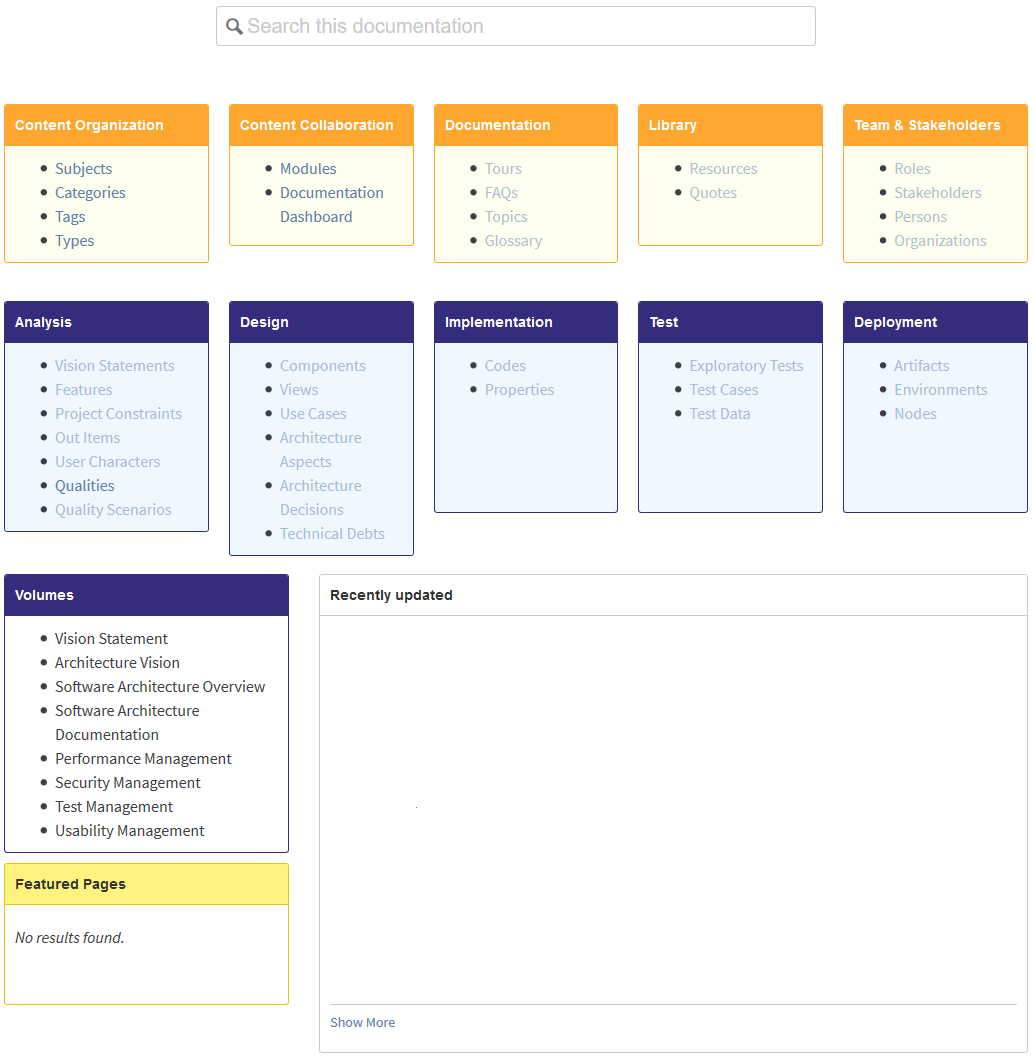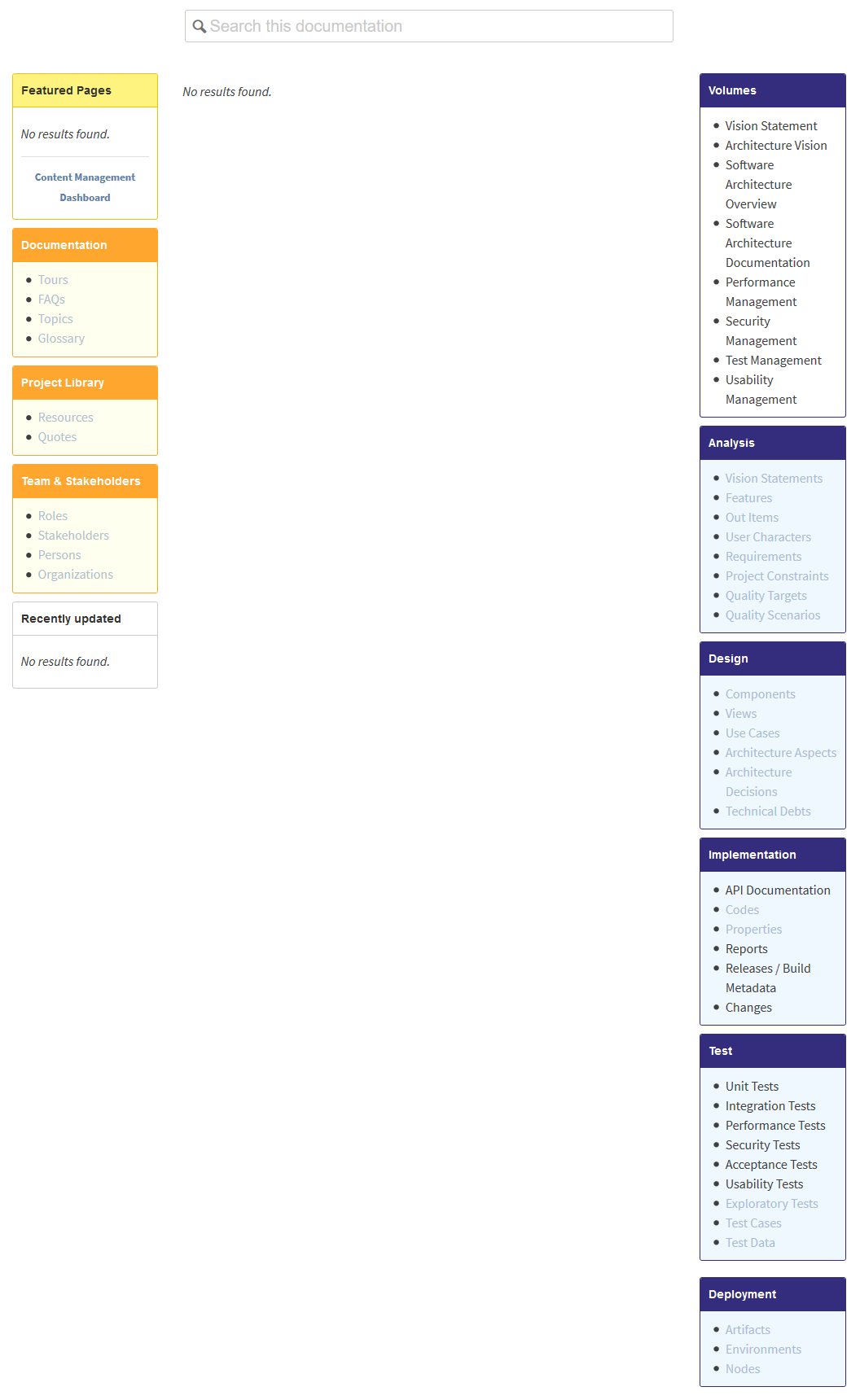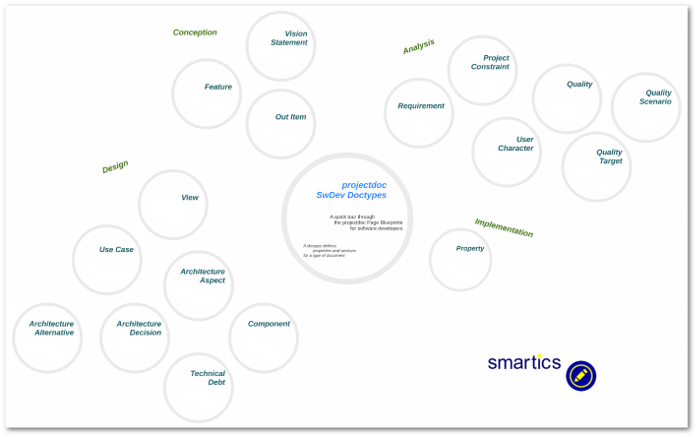Provides doctypes to create documentation in software development projects. The focus is on documenting the architecture of the product, but it includes templates for other software development documentation requirements as well.
All doctype add-ons are available in English and German language (except for the V-Modell XT add-on for which only German is supported).
For more information on this topic please refer to Localization.
Overview
The Doctypes for Software Development help agile teams to document their software architecture.
Create a space and you have a basic structure, a repository, to add the relevant information for your stakeholders.

The screenshot on the left shows the author's view. It contains links to documentation modules and types, tags, categories you usually want to see as an author, but not as a reader. See it as the authors' working dashboard. The space homepage contains the links that are relevant for readers. It is the landing page of the space.
This is the landing page provided by the The Software Development Add-on:

It leaves more space to add information most relevant to the readers of this space.
After you have created your space use the page blueprints to create documents for project constraints, requirements, views, architecture aspects (aka concepts) and many more.
The different topics are part of a document that comprise usually one wiki page. Since these pages are loosely coupled, they can be combined for different audience groups (e.g. using Tours or Volumes) easily. This makes it natural to run single source documentation principles and employ advanced features like transclusions or automatic lists. If the concepts you want to discuss are complex, you are not limited to a single page. Use the Section or other doctypes to create pages for modular content.
Due to home and index pages it is easier for authors to store new documents.
Prerequisites
The Doctypes for Software Development requires the projectdoc Toolbox to be installed. The projectdoc Toolbox has a commercial license.
The add-on also uses blueprints from the Core Doctypes for projectdoc (like Role or Stakeholder). This add-on is available on the Atlassian Marketplace for free.
Please install the following add-ons on your Atlassian Confluence server:
List of Doctypes for Software Development
The following doctypes help to document your software projects.
This list can be overwhelming, but using the templates is usually quite straight forward. To get a quick overview we suggest to open the Prezi presentation (the one we mentioned on the top of the page) which groups the logically closely related document types.
Mind some basics given in How to document a Software Development Project?
For an introduction to using projectdoc doctypes and macros from the author's point of view, have a look at the following documents:
- Tour for Document Authors
- Tour through the documentation for users who want to learn to create documents based on projectdoc doctypes.
- Software Project Documentation
- How to start your software project documentation? Here are the steps to get started with Confluence and the projectdoc Toolbox.
To organize your information about your software or system, you should have a look at the projectdoc Add-on for arc42. The arc42 Template provides a standard layout of chapters.
On the arc42 Template you can find a lot of useful tips on documenting architectures.
| # | Name | Short Description | Set | Documentation Type | Categories |
|---|---|---|---|---|---|
| 1 | Document a possible option for an architecture decision. Choose this document type to describe the alternative for a decision in more detail. This is typically a subpage of an architecture decision document. |
||||
| 2 | Group architecture alternatives by their type. |
||||
| 3 | Document an aspect of your architecture. Something orthogonal or cross-functional like logging, exception handling or configurability. |
||||
| 4 | Group architecture aspects by their type. |
||||
| 5 | Document a architecture decision for an option. This is useful to state the reasons and the options that have been evaluated. Later other team members will have it easier to understand the decision. |
||||
| 6 | Architecture decisions are group by their types. A commonly used decision type is 'Architecture'. |
||||
| 7 | Document requirements you impose on artifacts. Artifacts are created by processes defined and used by the team. This includes assemblies created by the build process, source code artifacts or reports. |
||||
| 8 | Artifact types categorize artifacts. |
||||
| 9 | Describe as a Blackbox the elements of a view where only the externally visible properties are relevant. |
||||
| 10 | Group blackboxes by their type. |
||||
| 11 | Describe the codes that are part of the product's API. |
||||
| 12 | Code types categorize codes, used in logging or exception handling. |
||||
| 13 | Components are part of a view on a system. A component may refer to a enclosed element or to a complete system of its own. |
||||
| 14 | Component types categorize components. |
||||
| 15 | Document a data type for properties and codes. |
||||
| 16 | Data type types categorize data types. |
||||
| 17 | Document logical or physical groups of nodes. |
||||
| 18 | Type of an environment used by the project to deploy the application or the solution. |
||||
| 19 | Documents a feature of the product. The top features define the main aspects of the product. |
||||
| 20 | Feature types categorize features. |
||||
| 21 | Interfaces document how elements of the system communicate with elements of this and other systems. |
||||
| 22 | Group interfaces by their type. |
||||
| 23 | Nodes are part of environments where artifacts are deployed to. |
||||
| 24 | Node types categorize nodes. |
|
|||
| 25 | Out Items record topics that are out of the scope of the project. This is useful for project inception and for reference in the future. |
||||
| 26 | Out item types categorize out items. |
||||
| 27 | Project Constraints limit the options of a project. |
||||
| 28 | Project constraint types categorize project constraints. |
||||
| 29 | Frame the vision for a project or iteration. |
||||
| 30 | Types to categorize vision statements for projects. |
||||
| 31 | Properties are part of the configuration options of a system. |
||||
| 32 | Property types categorize properties of products, such as parameters or configuration options. |
||||
| 33 | Qualities describe desired aspects of the product. |
||||
| 34 | Quality Scenarios document required qualities. |
||||
| 35 | Quality scenario types categorize quality scenarios. |
||||
| 36 | Documents a quality target for a product. |
||||
| 37 | Group quality targets by their type. |
||||
| 38 | Documents requirements of a product. |
||||
| 39 | Categorization of requirements for a product. |
||||
| 40 | Technical Debts track issues to be paid back. |
||||
| 41 | Technical Debts are grouped by the area they address. |
||||
| 42 | Document a test case of your project. |
||||
| 43 | Test case types categorize test cases. |
||||
| 44 | Defines a charter to run an exploratory test session. |
||||
| 45 | Test charter types categorize test charters. |
||||
| 46 | Document data used for test cases. |
||||
| 47 | Test data types categorize test data. |
||||
| 48 | Documents the results of a test session for the sponsoring stakeholders. |
||||
| 49 | Test report types categorize test reports. |
||||
| 50 | Defines a document to collect information during a test session. |
||||
| 51 | Test session types categorize test sessions. |
||||
| 52 | Defines a use case of the product. |
||||
| 53 | Use case types categorize use cases. |
||||
| 54 | User Characters are the actors of user stories. They include personas and extreme characters. |
||||
| 55 | User character types categorize user characters. |
||||
| 56 | Different views on the product help to document the system and its architecture. Typical views are building block, runtime, or deployment. |
||||
| 57 | Groups the views at a system. |
||||
| 58 | Describe as a Whitebox the elements of a view where only the relations of internal elements are relevant. |
||||
| 59 | Group whiteboxes by their type. |
Related Macros
The following macros are provided by this add-on.
- User Story Macro
- Renders a user story of a user story doctype.



